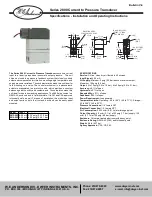
IGSITRPDS3-1
Installation Guide
3.
Remove the nipple from the transmitter by unscrewing the lock-ring nut on the transmitter. Save the
thin, white Teflon
2
gasket.
4.
Screw the dummy plug into the nipple. See Figure 11.
1. Nipple
2. PMC Dummy Plug
3. Bevel
4. Process Vessel
5. Weld: 100-125 Amperes Recommended
1
M
A0
0
6
1
3
a
4
3
5
2
FIGURE 11 PMC Dummy Plug
5.
Insert the nipple into the vessel and tack weld in place at 6 points.
M
A
0
0
6
1
3
a
8
7
6
5
4
3
2
1
6.
Weld the nipple to the process vessel using 0.032”/316 stainless
steel rod as filler in the beveled area surrounding the nipple.
Adjust amperage for a continuous weld depth of 0.080”/2 mm
penetration. The weld sequence is shown in Figure 12.
7.
Clean and polish the weld to meet process requirements.
8.
Remove the dummy plug.
9.
Install the Teflon gasket and transmitter in the nipple. Orient
transmitter as required. Tighten the lock-ring nut on the
transmitter only enough to ensure a secure, leak-free seal. Do not
over tighten. Do not prevent the transmitter from rotating as the
lock-ring nut is tightened.
FIGURE 12 Weld Sequence
Enclosure Rotation
1.
Loosen the enclosure setscrew using a 3/32" Allen wrench. The enclosure can be rotated
approximately 135º in either direction from the point where the enclosure rotation arrow points
directly at the enclosure setscrew. See Figure 13.
IMPORTANT
If the high end of the ramp-shaped recess in the enclosure neck is rotated past the
enclosure rotation arrow on the measuring cell, damage to internal electrical
connections can occur, requiring replacement of the measuring cell.
After positioning the enclosure, tighten the enclosure setscrew to between 30.1 in-lbs and 31.9 in-lbs
(3.4 N-m and 3.6 N-m).
2.
Go to the next section to orient the display.
2
Teflon® is a registered trademark of E. I du Pont de Nemours and Company
February 2012
13


































